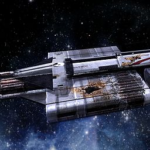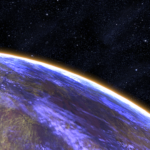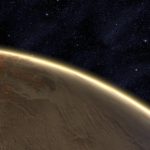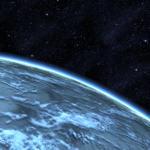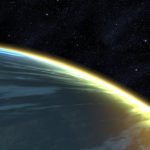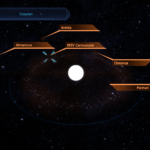System Specs:
- Stellar Mass: >40 Sol Masses
- Stellar Class: O
- Luminosity: >40,000 Sol
- Planets: 4
- Moons: 0
- Asteroid Belts: 1
- Asteroids: 0
- Objects: 1
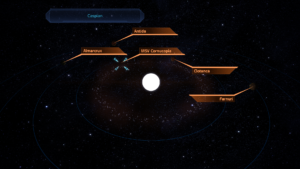
–
Planets Directory:
- asteroid belt
- MSV Cornucopia
- Clotanca
- Farnuri
- Almarcrux
- Antida
–
MSV Cornucopia:
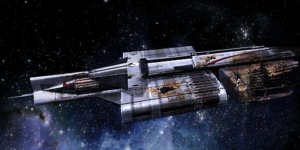
The Cornucopia is a Kowloon Class modular conveyor of human design. While obviously adrift, the Cornucopia is not broadcasting any distress call.
Registry: ExSolar Shipping, Sol
Assignments
Assignment: UNC: Derelict Freighter
“This mission just got a lot more complicated.” — Spoilers for Mass Effect follow.
Mass Effect
The Cornucopia was near the Perseus Veil when its crew discovered an artifact that apparently brainwashed them. They set a course toward the Veil, but there’s no record of how the ship got back into human territory.
The derelict carries a cargo of dragon’s teeth. Its crew have been all transformed into husks.
–
Clotanca:
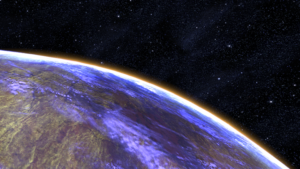
- Orbital Distance: N/A AU
- Orbital Period: 124.7 Earth-years
- Keplerian Ratio: N/A
- Radius: 7,810 km
- Day Length: 19.7 Earth-hours
- Atmospheric Pressure: 0.73 atm
- Surface Temp: 92 °C
- Surface Gravity: 0.78 g
- Mass: 1.161 Earth-masses
Clotanca is large but low-density terrestrial world with an atmosphere of nitrogen and carbon monoxide. Its crust is mainly composed of sulphur and unremarkable silicates. Occasional deposits of heavy metals, usually the result of meteor strikes, dot the surface.
High speed winds, powered by the hot blue star Caspian, present a constant hazard. Atmospheric entry is hazardous, and EVAs are discouraged.
–
Farnuri:
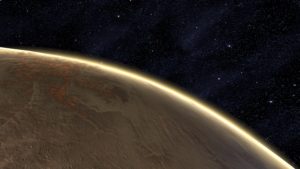
- Orbital Distance: N/A AU
- Orbital Period: 352.7 Earth-years
- Keplerian Ratio: N/A
- Radius: 8,968 km
- Day Length: 67.8 Earth-hours
- Atmospheric Pressure: 0.00 atm
- Surface Temp: −98 °C
- Surface Gravity: 1.2 g
- Mass: 2.355 Earth-masses
Farnuri has a trace atmosphere of carbon dioxide and helium. The surface is mainly composed of silica laced with iron oxides, indicating the world had an oxygenated atmosphere at some time in the past. Given the relative youth of the blue star Caspian and the significant gravity well of Farnuri, this must have occurred with astonishing swiftness, perhaps a result of some cataclysmic event. Further research is required.
–
Almarcrux:

- Orbital Distance: N/A AU
- Orbital Period: 584.1 Earth-years
- Keplerian Ratio: N/A
- Radius: 4,715 km
- Day Length: 64.7 Earth-hours
- Atmospheric Pressure: 0.76 atm
- Surface Temp: 31 °C
- Surface Gravity: 0.78 g
- Mass: 0.423 Earth-masses
Almarcrux has an atmosphere of methane and ethane. Despite the distance from Caspian, the energetic young star heats the surface to almost temperate levels. Thick ground fogs are common at the terminator, where water ice frozen during the long dark side night meets the warm air masses from the day side. The crust is mainly composed of copper with deposits of sodium.
Almarcrux’s abundant water and relatively mild temperature and gravity have placed it on the short list of terraforming candidate worlds. However, there is significant opposition from eco-ethics groups, who assert that Almarcrux’s primitive methanotrophic bacteria may be a precursor to a full-fledged native ecology.
–
Antida:
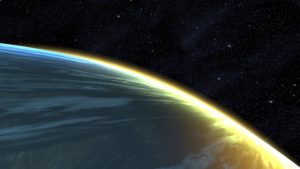
- Orbital Distance: N/A AU
- Orbital Period: 1,296.1 Earth-years
- Keplerian Ratio: N/A
- Radius: 29,657 km
- Day Length: 12.8 Earth-hours
- Atmospheric Pressure: N/A atm
- Surface Temp: N/A °C
- Surface Gravity: N/A g
- Mass: N/A Earth-masses
Antida is a standard hydrogen-helium gas giant. Its atmosphere is darkened by traces of sodium. It is one of relatively few planets known with an orbital period of more than a millennium.
Survey Text
“Scans of Antida revealed a group of defunct turrets orbiting the planet. The recon team carefully retrieved one of the turrets and brought it on board. Tali dismantled the weapon and found it was marked with a Carthaan Outpost insignia.”
–
–

